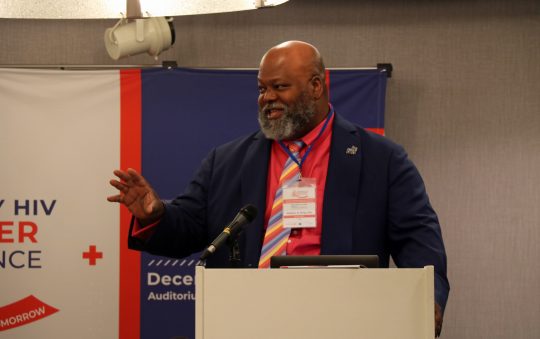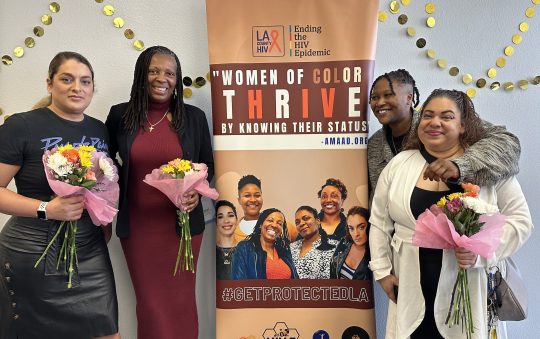
Recently, I read an article in the LA Times, that sexually transmitted disease (STD) cases are reaching all-time highs in the U.S.; but the story had a central focus on California. This new data showed that cases of chlamydia, gonorrhea and syphilis, in California alone, had reached an all-time high. Well, you know where my head went; “I guess the conversation about the use of condoms and safer sex practices is a thing of the past.” After all, popping pills is the wave of the future, isn’t it? Could it be because of all the conversations going on, all around the country about the new tools in the tool box, i.e. Pre-exposure prophylaxis (PrEP) and treatment as prevention, now communities and the Centers for Disease Control and Prevention (CDC) are finding ourselves scrambling to address these new cases of STDs breaking out all over the country with California leading the way?
You know WHY we’re scrambling to deal with this all-time high of new infections of chlamydia, gonorrhea and syphilis? It’s because we lost our focus on the basic things that prevent the spread of STDs…condoms! In our efforts to try and find new and innovative “shortcuts” we forgot to teach and reach people on the basics. You know, you’re never going to get around the basics in anything; just think about it. No matter how good you get, in whatever area of life, when you find yourself slipping and not doing as well as you once had, what do you do; you go back to the basics. The basics in dealing with STDs is first and foremost, using condoms, male or female. The basics in dealing with STDs, ladies, is not confusing the words “I love you” as a doctor’s report. The basics, brothers and sisters is being a monogamist and if you can’t seem to do that, well, it’s being man or woman enough to protect your partner, lover, wife, husband, friend or booty-call out of harm’s way.
Don’t get me wrong, I’m as progressive as the next person and I understand that we’re moving towards biomedical EVERYTHING in this country. However, it’s by no accident that we, here in the US, make up only 7% of the world’s population, yet we healthy Americans consumes 75% of all the drugs manufactured in the world so I get it. We have a fixation and fascination in this country with drugs; legal and illegal. But, like I said, there are no short-cuts! Have you ever really, listened to those drug commercials, “Stop taking it if you feel your nose falling off, or if you can’t stop crying or you feel like killing yourself and others, stop and call your doctor or the LAPD.”
As great as PrEP is supposed to be, it is only as good as the condoms we’re using. Once again, there is no substitute or short-cut to protecting yourself and others. Don’t get me wrong, I’m not a luddite railing against progress in medical research and new developments in health care. So, I do understand, in life as well as in relationships, but we all know that as human beings, we have hiccups. I see PrEP and all other types of prevention methods as good things; my fear is that we will use new and innovative treatment modalities as short-cuts and we use them in the ways that were never intended, making the problems we face worse. Sure, we know PrEP reduces the odds of one becoming infected with HIV; but only if used properly. And the proper way to use PrEP is ALWAYS with a condom.
Isn’t it interesting that nationally, rates of these three diseases, chlamydia, gonorrhea and syphilis have fluctuated over the last five years, but all three surged in 2014? As many of us know, we ratcheted up our case for biomedical treatment-as-prevention movement and all but stopped arguing the importance of not becoming infected in the first. We shifted to; when you become infected you can take this… “PrEP” that is.
Now, more than ever, I see the CDC’s Partnering and Communicating Together to Act Against AIDS (PACT) project, as a way for us to get back to the basics. My organization, I Choose Life, is a key member in the CDC’s goal to stopping the spread of HIV and all other STDs. The PACT project is a partnership between the Centers for Disease Control and Prevention (CDC) and several of the nation’s leading organizations representing the populations hardest hit by HIV/AIDS. Through these collaborative approaches, PACT members work towards achieving the goals of the National HIV/AIDS Strategy (NHAS) by reducing new HIV infections, improving health outcomes for individuals living with HIV, and reducing HIV related disparities (inequities). As PACT members, we leverage our existing organizational structures, networks, and communication platforms to disseminate campaign materials using a variety of channels including publications, meetings, conferences, media and other mechanisms. For me, the beauty of the PACT project is that we’re getting back to the basics. I’m #DoingIt, how about you?







